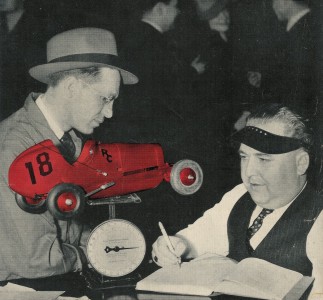|
Cable Track -- Cable racing was done on a level circular course typically dirt, concrete or asphalt. A single car was attached to the end of a cable with the other end attached to a pivot or center post. Speeds on cable tracks were much faster than rail tracks and cars were timed to track their speed.
Rail Track -- In rail racing, the cars raced on the surface of a board track usually consisting of 4-6 lanes. The cars were attached to a pair of ball bearings mounted on the front and back axle and guided by a rail on the track which added more fun for the spectators. It was like “real” racing. Rail racing enabled more than one car to be on the track at the same time.
Both Cable and Rail Cars -- were started using several techniques. Usually, the owner would run behind the car pushing it by hand or with a pole. Also, a bicycle was placed upside down and once the wheel was spinning, the car drive wheel would be placed on the bicycle wheel to get it going. Many owners built devices of their own design to get the wheels spinning.
To stop the car, a “kill switch” was used which had a wire attached to it so it could easily be triggered to stop the car. The owner using a pole, broom, rag, hat or a racing flag to trigger the kill switch.
|
 |



